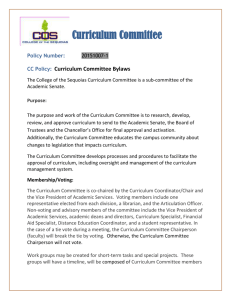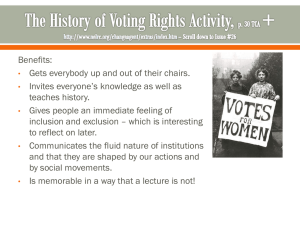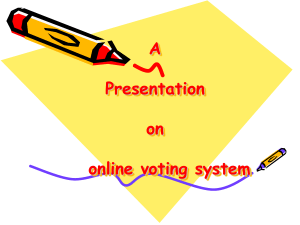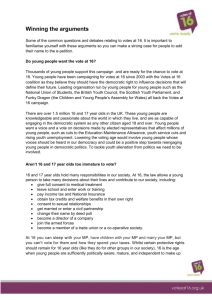The Elementary Statistics of Majority Voting L. S. Penrose Journal of
advertisement
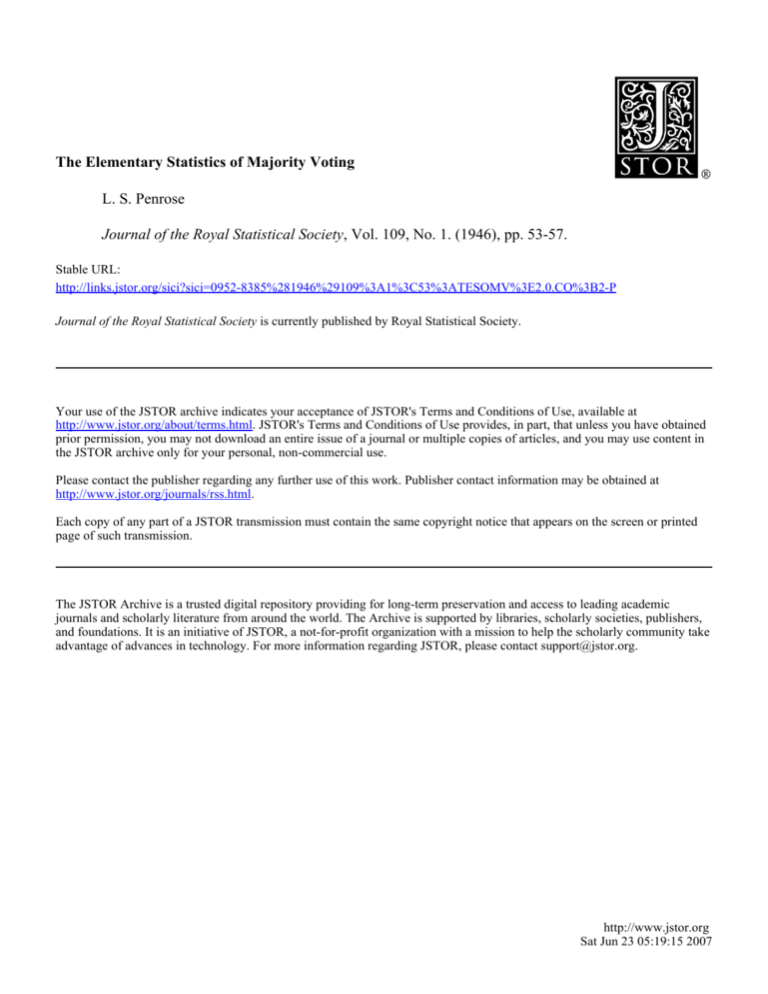
The Elementary Statistics of Majority Voting L. S. Penrose Journal of the Royal Statistical Society, Vol. 109, No. 1. (1946), pp. 53-57. Stable URL: http://links.jstor.org/sici?sici=0952-8385%281946%29109%3A1%3C53%3ATESOMV%3E2.0.CO%3B2-P Journal of the Royal Statistical Society is currently published by Royal Statistical Society. Your use of the JSTOR archive indicates your acceptance of JSTOR's Terms and Conditions of Use, available at http://www.jstor.org/about/terms.html. JSTOR's Terms and Conditions of Use provides, in part, that unless you have obtained prior permission, you may not download an entire issue of a journal or multiple copies of articles, and you may use content in the JSTOR archive only for your personal, non-commercial use. Please contact the publisher regarding any further use of this work. Publisher contact information may be obtained at http://www.jstor.org/journals/rss.html. Each copy of any part of a JSTOR transmission must contain the same copyright notice that appears on the screen or printed page of such transmission. The JSTOR Archive is a trusted digital repository providing for long-term preservation and access to leading academic journals and scholarly literature from around the world. The Archive is supported by libraries, scholarly societies, publishers, and foundations. It is an initiative of JSTOR, a not-for-profit organization with a mission to help the scholarly community take advantage of advances in technology. For more information regarding JSTOR, please contact support@jstor.org. http://www.jstor.org Sat Jun 23 05:19:15 2007 The Elementary Statistics of Majority Voting By PROFESSOR L. S. PENROSE 1. Introduction . . . . . . . . . 2. Decisions made by majority vote (a) The power of a single vote (6) The power of a bloc vote ......... ......... ......... ......... Hierarchies . . . . . . . . . . . . . . . 3. Representation . . . . . . . . . . . . . . . . . . . (a) Groups of different sizes . . . . . . . . . . (b) Groups of spokesmen . . . . . . . . . . . . 4. Suggestion for votes in a world assembly . . . . . . 5. Summary .................. (c) PAGE 53 53 53 53 54 55 55 55 56 57 THEarithmetic of voting has received surprisingly little attention from either politicians or sociologists, except from the purely actuarial point of view. y e t there are a few very simple and obvious statistical rules which can apply to decisions made by majority vote, whether the vote is actually taken or only implied potentially, and which deserve to be better understood. The equitable representation of political opinion is partly a question of statistical probability and, since stable and representative government, both on the national and federal levels, is probably essential to the well-being of mankind, sooner or later these matters must be properly investigated. In the present communication, some suggestions are made in the hope of stimulating further discussion of the subject. 2. Decisions made by majority vote (a) The power of a single vote The most elementary case is that in which a committee makes a decision by majority vote in favour of, or against, a given proposal. This method of procedure is almost universal in civilized human communities and may be said to be a basic democratic principle approved, for example, by all members of the United Nations. The fact that, in practice, a great many decisions are takgn without formal voting does not alter the essential arithmetical basis. Typical cases where decisions are taken without actual voting are: (i)bwhen a spokesman acts on behalf of the majority of a committee, (ii) when a majority acquiesces in a decision with the knowledge that a vote would not alter the result, and (iii) when agreement is a mere formality to confirm a decision already reached. The numbers obtained in actual voting, especially when voting takes place by a show of hands, are often influenced by the desire of voters to be on the winning side, so that the majority appears to be larger than it really is. In a committee of three people one member will obtain the decision of his choice-that is to say, he will be on the winning side in 75 per cent. of the votings, if the other two members vote in a random manner. In a committee of five, the chance that one member will obtain the decision he wishes will be I I 116. In general,.the power of the individual vote can be measured by the amount by which his chance of being on the winning side exceeds one half. The power, thus defined, is the same as half the likelih~odof a situation in which an individual vote can be decisive-that is to say, a situation in which the remaining votes are equally divided upon the issue at stake. The general formula for the probability of equal division of n random votes, where n is an even number, approaches 2/2% when n is large. It follows that the power of the individual vote is inversely proportional to the square root of the number of people in the committee. Thus the individual vote has just half as much power (in the sense here defined) in a committee of 400 as it has in a committee of twenty. (b) The power of a bloc vote The individual may feel flattered by the knowledge that his voting power does not diminish as rapidly as he might have expected, when the size of the electorate increases, but a phenomenon of more practical importance to him concerns the power of a bloc vote. If a committee or electorate 54 [Part I , Miscellanea consists of two sections, a " resolute" bloc and an " indifferent" random voting group,* a small " resolute " group of people, who always vote together can exercise a surprisingly powerful control over the whole committee. Thus, three resolute votes can control a committee of twenty-three t o the same extent that one vote can control a committee of three. Furthermore, a bloc of twentythree could control, again to the same extent, an electorate of over 1,000, and a bloc of 1,000 could likewise control the decisions of an indifferent electorate of over z,ooo,ooo. These blocs have about a 75 per cent. chance of carrying the decision in their respective electorates, but, by increasing the size of the resolute bloc, any specified degree of control can be obtained. Blocs three times as great as those mentioned would carry the decisions they desired in nearly 96 per cent. of the situations encountered. A bloc. of size.2/nalways can carry 84 per cent. of the decisions, when the X indifferent group has n voters, and a bloc of size d n c a n carry i(1 area under the normal probability curve as given in the usual tables. + a) decisions where a is the (See Table 1.) Percentages of decisions controlled by resolute blocs Indifferent popuaton 1 CI% I 97.i~ 1 99.9% Population of resolute bloc I I The important statistical fact which emerges from this discussion is the very high degree of control exercised by a comparatively small resolute group when the indifferent population is very ndmerous. The same degrees of control are obtained in two populations by blocs proportional in sizes to the square roots of the respective population numbers. It is obvious that the successful control of voting by a small minority depends on the indifference of the remainder of the electorate. If the remainder breaks up into blocs of dimensions similar to those of the original resolute bloc, the power of this original bloc is lessened; the situation reverts approximately to that in which each bloc can be treated as an individual, and the population then behaves like a small committee with each bloc acting as one member. (c) Hierarchies The controlling power of an individual or of a small bloc, can be increased by setting up a hierarchical structure such as is commonly found in authoritarian and semi-authoritarian systemse.g., in military, ecclesiastical and ifldustrial organizations. ' The necessary condition for such increased control by a few is that the decision made by any sub-group shall be, at least temporarily, binding on all the members of that sub-group, so that each sub-group forms a bloc in relation to a largerpopulation. Such a sub-group can, in its turn, be controlled by other smaller sub-groups in the,same manner and, ultimately, a very small resolute bloc can control the decisions of millions of indifferent voters. I n many forms of hierarchical control, notably in armed forces, votes are not taken, and control is exercised by the potential majority. To obtain the most efficient results from hierarchical control, the basic population must be prevented from forming blocs of any kind and must be kept in a state of indifference. The recent German dictatorship, for example, was astute enough to realize the importance of breaking up even the apparently most harmless clubs and societies and of keeping the population, so far as was possible, ignorant of political issues. * These terms " resolute " and " indifferent " were suggested by G. Beall. 19461 The Elementary Statistics of Majority Voting 55 3. Representation (a) Groups of dzyerent sizes Once a decision has been made by majority vote, the action taken in consequence of this decision may be said to be in accordance with the wishes of all those voting in favour of it. Nevertheless, the same result could have been achieved if only the excess of voters, who constitute " edge" or the majority by which the vote was carried, had been in favour of the resolution and the remainder of the committee had been indifferent to the issue and had " paired " their votes. Thus, we can only be certain that a majority decision represents the views of the controlling " edge" of the voters. For example, if sixty people voted in favour of and forty against a resolution, only twenty people (those referred to here as the " edge ") certainly attained the decision of their choice, because the remaining eighty votes could have been paired indifferently. If this principle is accepted, it follows that the degree of representativeness of a decision depends upon the magnitude of the " edge." In the same committee this quantity will vary each time a vote is taken, but over a long period it will obtain an average value which is determined, among other things, by the square root of the number of voters. When a committee of IOO makes a decision by majority vote, this decision is likely to represent the opinions of half (and not one quarter, as might have been expected) as many people as would a decision made by a committee of 400. This result is an illustration of a familiar statistical principle-namely, that the significance of any observation depends upon the square root of the number of cases upon which it is based. The argument can be carried a step further, for, in most forms of government, a population elects one or more spokesmen to act on its behalf. The views of such a spokesman are likely to be representative of a larger proportion of the people in a numerically small electorate than in a numerically large electorate. If, for example, a spokesman represents the considered views of ten out of a committee of 100, he will represent the views of twenty, or only 5 per cent. of a committee of 400, when all conditions other than those relating to the size of the committee remain constant. Consequently, governments representing relatively small groups of people (e.g., small nations) are likely to be more representative, in the sense that they are likely to act in accordance with the views of larger proportions of their populations, than governments representing relatively large groups of people. Conversely, small groups of people or small nations are less easily controlled by resolute fractions or minorities than are large groups or nations. If democracy is defined as a condition in which the government tends to carry out the wishes of the people, small nations, by virtue of their smallness, are likely to be more democratic than large nations. A specially constructed hierarchical system of government, which concentrates power of decision into the hands of a very small bloc, can lead to a situation where the spokesmen for a nation are representative only of a very small proportion of the people's opinions. The proportion of the electorate represented by the opinions of the bloc which governs by hierarchical control becomes naturally smaller as the electorate becomes more extensive. (b) Groups of spokesmen By electing a spokesman, who is to take his place in an assembly of spokesmen units, a group reduces itself to a resolute bloc of oneunit. Should a set of electorates, all of the same size, contribute one member each to an assembly, the situation is reduced to that of a committee of spokesmen in which the power of each member can be duly estimated from the size of the committee. In such a case each member of the original set of electorates is symmetrically and fairly represented in the committee. Important inequalities arise, however, when the contributing electorates differ in size from one another. For example, in a federal assembly of nations, would it be equitable for two nations of the relative sizes of China and Switzerland each to have one vote? On the other hand, would it be any fairer if the greater one had IOO times as many votes as the lesser, as would result from allotting voting power or membership in the assembly on a strictly " per capita " basis? The answer seems to be that the number of votes (or members) which each nation contributes to an assembly of spokesmen should be proportional to the number of people whose opinions sach spokesman probably represents. The number of people represented by the spokesman of each electorate has been shown to be proportional to the square root of the number of people who can vote. A nation of 400 million people should, therefore, have ten times as many votes (or members) on an international assembly as a nation of.4 million people. , 56 Miscellanea [Part I. 4 . Suggestion for votes in a world assembly Ideally. every responsible human being should have equal power in a world assembly. This situation. however. can only arise in an assembly of nations of equal sizes. each enfranchized to the same degree. To award nations voting powers proportional to their populations would give the spokesmen for large nations too much power in relation to the numbers of their sponsors . On the other hand. if. as at present arranged. large and small nations have equal voting powers. the spokesmen for small nations are felt to be too significant. and artificial rules about the meanings of votes and vetoes have to be constructed to redress the balance . Let us examine some of the consequencks of basing the voting power in a world assembly upon the square root of the number of persons in each nation's electorate. In the first place. advantage would go to the nation with an extensive franchise . The necessity for some general rule to exclude children. the grossly illiterate and the insane from voting in every country would naturally follow . Secondly. though a nation could gain in voting power. if it grew or absorbed other nations. it would have to grow to four times its size in order to double its voting strength . Conversely. if a nation divided into four equally large independent administrations. which had common friendly interests. the new group of states would possess double the voting power of the old one. and it would be twice as representative of the people . TABLE 2 Nation U.K. ...... Canada . . . . . . South Africa ... Australia ... New Zealand ... India ...... U.S.A. . . . . . . U.S.S.R. ... Ukraine . . . . . . White Russia ... France . . . . . . China . . . . . . Belgium . . . . . . Czechoslovakia ... Denmark ... Greece . . . . . . Netherlands ... Norway . . . . . . Poland . . . . . . Yugoslavia ... Iraq ...... Iran ...... Syria ...... Abyssinia ... Egypt . . . . . . Liberia . . . . . . Mexico . . . . . . Guatemala ... ...... Cuba Haiti ...... ... Argentina Bolivia . . . . . . Brazil . . . . . . ...... Chile Columbia ... Ecuador . . . . . . ...... Peru Uruguay ... Venezuela ... 1 . . . . . . . . Approximate potential electorate (pre-war figures in millions) (a) Members of United Nations ........ 30.0 . . . . . . . 7.0 ........ 5.7 ........ 4.0 ........ 1.0 ........ 235.0 . . . . . . . . 91.0 ........ 71.0 1 The Elementary Statistics of Majority Voting Nation 1 Ap~roximate potential electorate (prerwar 1 Voting power, i.e., squase root of potential electorate (in thousands) (b) Otl~er Austria . . . . . . Bulgaria . . . . . . Finland . . . . . . Germany ... Hungary ... Italy ...... Portugal . . . . . . Rumania ... Spain . . . . . . Sweden . . . . . . Switzerland ... Turkey . . . . . . Afghanistan ... Japan . . . . . . Malaya . . . . . . Arabia . . . . . . Nepal . . . . . . Siam ...... Tibet ...... Yemen . . . . . . Morocco ... Eire ...... Ceylon . . . . . . Sudan ... British West 1n&s Total ...... . .I 1,162.2 202.1 Clearly, a lower limit to the size of a nation is required to stop indefinite subdivision. This limit would be determined by the maximum number of seats or votes thought suitable in the assembly. One vote per million electors would imply less than 2,000 for the maximal size of a hypothetical world assembly of z,ooo nations. The political world as at present constituted, with its predominance of large nations, would not require more than about zoo seats in an assembly built up as suggested here. Assuming that all participant nations were equally franchized, say up to two-thirds of their populations, we should get a world assembly something like that indicated in Table 2. Nations with electorates less than I million are excluded. The appropriate voting powers, based upon theper capita system and the square roots of the electorates, can be compared. Each nation represented on the world assembly would, theoretically, be required to furnish a credible list of voters. Fortunately, errors in making up such lists will be less significant in large than in small electorates on the system here described. 5 . Summary The application of some elementary statistical principles to the problem of representative government leads to the conclusion that small electorates are less susceptible to control by resolute blocs and are likely to obtain more representative governments than large electorates. If factors other than numerical size are constant, the spokesman for any electorate represents a section of that electorate proportional to the square root of the total number of electors. The suggestion is made that the voting power of each nation in a world assembly should be proportional to the square root of the number of people on each nation's voting list.

